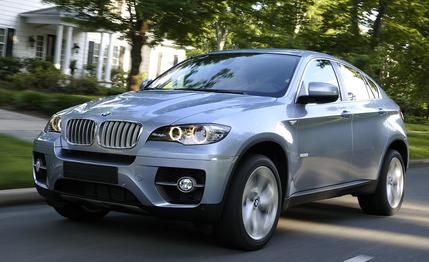 First Drive Review
First Drive Review
Although BMW initially shunned hybrids in favor of clean diesels and other alternative powertrains, the German automaker is joining the electrically assisted fray next year with not one but two gasoline-electric vehicles: the 2010 BMW ActiveHybrid 7 and the 2010 BMW ActiveHybrid X6.
Both models share ActiveHybrid badging and fall in the contradictory performance-hybrid segment, but their similarities end there. The 7 is a mild hybrid that uses an electric motor in its eight-speed automatic gearbox and a compact lithium-ion battery mounted in the trunk to assist acceleration and run the accessories; the X6 is a far more complex full hybrid. The latter’s pair of motors and advanced electronic continuously variable transmission allow it to waft up to 1.6 miles and at speeds of up to 37 mph on electric current alone. Forget about Prius-like fuel economy, though, because the ActiveHybrid X6 is the most powerful hybrid yet produced, with the electric bits combining with a 400-hp, 4.4-liter twin-turbocharged V-8 to produce a total output of 480 hp and 575 lb-ft of torque. (When pressed on why it didn’t choose to pair the hybrid system with the X6 xDrive35i’s twin-turbo six-cylinder, BMW simply says that using the V-8 made for the largest jump in efficiency. Plus, the company added, the resulting vehicle would be slower.)
Two Modes and Lots of Explaining
Based around the two-mode CVT BMW co-developed with General Motors and the old DaimlerChrysler, the X6 hybrid is similar in concept to hybrid versions of GM’s full-size SUVs and pickups, as well as the short-lived Dodge Durango and Chrysler Aspen hybrids and the upcoming Mercedes-Benz ML450 hybrid. That concept in a nutshell: Take a big vehicle with a relatively inefficient, large-displacement engine and pair it with an electrified transmission that keeps the powertrain at maximum efficiency no matter what the speed to improve city fuel economy without sacrificing highway efficiency.
Compared with the GM and Chrysler examples, which blend CVT operation with two electric motors and three planetary gearsets for a total of four fixed gear ratios, the X6’s unit stirs in three additional, “virtual” ratios, effectively making the transmission a seven-speed for better dynamic performance. As with the normal X6, manumatic shifting is performed via the console shifter or wheel-mounted paddles. The two electric motors within the gearbox—rated at 91 and 86 hp and 192 and 206 lb-ft of torque, respectively—assist with high- and low-speed mobility while also helping to recapture wasted energy through regenerative braking. The juice, stored in a 2.4-kWh nickel-metal hydride battery pack under the floor of the X6’s cargo hold (it lives where conventional X6 models keep their spare tires; run-flats are standard on the hybrid), is then fed back into the system and on to the drive wheels.
It Moves, Stops, and Turns
On the surface, the X6 ActiveHybrid feels much like the all-wheel-drive X6 xDrive50i on which it’s based. And that’s a good place to start, because although we still find the vehicle’s overall design and purpose confusing, it’s fast, agile, and immensely capable, despite weighing in excess of 5200 pounds. The X6 hybrid even retains the regular model’s torque-vectoring rear differential, which allows for physics-defying changes in direction by actively routing power to the outside rear wheel when cornering. It might not be the most efficient package on which to base a hybrid, but the X6 is one of the sportiest platforms yet to gain the ability.
However, the preview-drive route BMW chose in and around downtown Miami offered little insight into the X6 hybrid’s dynamic behavior. Cruising through the city, we noticed the engine smoothly and routinely shut off and restarted at stoplights (unless we were in sport mode or if the battery was nearly drained). Accelerating using electric-only power could be done with a fair amount of throttle, unlike in some other hybrids where the engine cuts in at even a hint of pedal movement. There occasionally was some hesitation when we quickly jumped to the accelerator and the hybrid system’s electronic brain had to decide how best to direct the power to all the gears and motors, but the vehicle definitely was quick once it got moving. Despite the added 400-ish pounds of hybrid gear, BMW says the ActiveHybrid is only 0.1 second slower to 60 mph—5.4 seconds—than the nonhybrid V-8 X6. We think a 5.2-second time is possible, given that our long-term X6 xDrive50i managed the task in 5.1. Top speed is electronically limited to 130 mph, and towing capacity is a substantial 6000 pounds.